Contents
With the rise to prominence of display marketing across the web, we think it’s essential that you get to know the intricacies surrounding, what can be, a confusing and difficult digital minefield to manoeuvre. This will enable you to maximise conversions and optimise your digital campaigns to ensure you really are getting the best bang for your buck when it comes to display banner ads and bringing more traffic to your website.
What is a display ad?
A display ad is an advertisement that usually appears on websites, apps, and social media. These ads are usually displayed as graphics, videos, and images, designed to grab attention and spread brand awareness.
What is a banner ad?
A banner advertisement is a type of display ad which is commonly used and embedded onto web pages. Banner ads are usually comprised of a graphic made with the purpose of driving traffic towards a specific website or web page.
What’s the difference between display and banner ads?
Technically speaking, not a lot. Banner ads by nature are a form of display ad that is specifically designed to generate web traffic, usually in the form of a static graphic. Conversely, display ads are usually more variable in design and can be used in more ways than just a static web traffic generator.
Benefits of Display Banner Ads
Benefit #1: Banner ads are affordable
Banner ads are comparatively cheaper than most forms of online advertising, especially if you are able to create the banners yourself or internally. Additionally, if your banner ad campaign is managed by an experienced professional, they can optimise your campaign often to maximise return on investment.
If you’re looking for professional PPC and display ad management, then click here to find out more!
Benefit #2: Banner ads are great at spreading brand awareness
Even if they don’t generate the desired web traffic, banner ads definitely do a great job of spreading brand awareness due to their scope and coverage. It’s not uncommon to see display ads make an impression on hundreds of thousands of people and whilst not every web user will be clicking these ads, they will be exposed to your businesses and know what you’re about (if you have an effective and simple to read banner ad).
Benefit #3: Banner ads allow you to target your audience
Like most display ads, you can target various people using the tools that Google Ads provide. This includes targeting specific demographics, audiences, locations, keywords, topics, or websites. This hyper-targeting technique is a surefire away to ensure you are truly optimising your budget.
Benefit #4: Results from banner campaigns are measurable
Most traditional variations of display marketing are incredibly difficult to gather data for, which makes these forms of traditional advertising risky in our modern-day and evergreen world. Return on investment (ROI) is a key metric when spending your money on advertising, so it is pivotal that these financial risks are measurable in order to justify your spending. Banner ads are perfect for this, as you can see crucial statistics such as impressions, clicks, ad spend, conversions, and so on. Don’t miss a trick by overlooking how valuable these statistics are!
Benefit #5: Banner ads are relatively easy to create
Banner ads don’t have to be intricately designed by a master graphic designer to be successful. Sometimes, all it takes is the right software, a clear direction, and some nice content – this could be an eye-catching picture, some informative text, and an effective call to action. As long as it’s efficacious and on-brand, you can’t go wrong. There is plenty of free or premium software available to use to create banner ads, including Adobe Illustrator, Canva, GIMP, and many more.
Disadvantages of Display Banner Ads
Disadvantage #1: Banner ads can be too minimal
There’s a thin line between too minimal and too much when it comes to banner ads. If you put too much information and content on your ad, it can easily become convoluted and harder to read, which will negatively affect your click-through rate.
Contrarily, if there is too little information and eye-catching content on your banner, it can be easily avoided on a web page. This is known as banner blindness and is when users avoid/block out your banner ads as they are used to doing this on the internet and your banner ad looks too generic or bland.
Disadvantage #2: Click-through rates are lower on banner ads
When compared to normal text ads, banner ads do have a lower click-through rate. A click-through rate is a metric that is generated to give the advertiser a percentage of users that click on their ad and carry onto the desired landing page. The average click-through rate for a plain text ad sits at around 2%, with anything above 3% being a great benchmark for success.
Alternatively, banner ads have an average click-through rate of just 0.25%, with 2% being the benchmark for these types of ads. However, whilst it might look like text ads are the clear winner here, it can be argued that the quality of leads generated from banner ads are of a higher quality and are more effective at spreading brand awareness.
Disadvantage #3: No guaranteed results with banner ads
Whilst this can be said for any form of advertising, it can be easy to fall into the trap that is the belief of guaranteed clicks from a banner ad. The only thing guaranteed from banner ads are impressions and increased brand awareness, apart from this, conversions, leads, and clicks can only be obtained by having a quality ad paired with competent PPC management.
Disadvantage #4: Banner ads *can* have a higher CPC than text ads
CPC (Cost Per Click) is the average amount it costs to generate a click on your ad from your designated ad budget. Due to banner ads usually having lower click-through rates than text ads, it results in a higher CPC. This happens because you are technically receiving fewer clicks for a similar budget to text ads, these lesser clicks will bring your CPC up and that’s never good.
However, like the click-through rate issue, it seems these slightly negative metrics don’t tell the full story, as it doesn’t account for the rise in brand awareness (which is virtually immeasurable) or the number of people who may visit your site after viewing the ad, but didn’t click it directly.
You can be sure to increase your CPC by using a well-structured banner ad and optimising the display campaign regularly.
Display Banner Ads: Best Practices
If you’re planning on designing some display banner ads yourself, but have no experience in doing so – then these tips on the best practices for banner ads will go a long way.
Use high-quality images in your banner ads
Banner ads must be clear to see and using a high-quality image is the best way to look and feel clear. This includes using images that aren’t blurred, visually impaired, monotonous and have a suitable composition. If you find yourself skewing an image to fit into your ad or using colours and palettes that all blend into one, you won’t have a very effective ad.
Make use of a frame for your ads
Frames are important as they make your ad stand out from the page ever so slightly, which can help improve your click-through rate and get your ad noticed even more by avoiding the dreaded banner blindness. It’s also worth noting that if your banner ad contains a white background, then an edge/frame is compulsory according to Google’s guidelines, as they believe it’s an attempt at making an ad seem native to the website by blending into the page.

A fine example of how to use a frame on a banner ad
Don’t overdo it
As mentioned previously, there’s a fine line between overcomplicating and oversimplifying your ads. It’s important to avoid flooding your ads with pictures, graphics and information as it can confuse and repulse potential leads. Too much content can give your ad shockingly bad composition and make it look cluttered, making it harder to get across the main message of your banner ad.
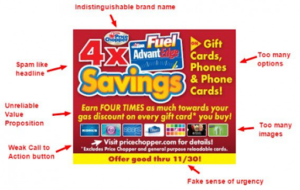
Avoid looking like this banner ad
Utilise an effective call to action
CTAs (calls to action) are what gets users to click on your ad and progress to your landing page. You need to take into account various elements of the CTA before creating it, including the length, colours, shapes, and positioning. Below is an example of a good CTA and a not-so-good CTA.
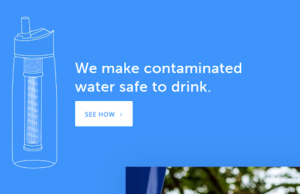
With this ad, you can see that there is a clear contrast between their CTA button and the background, which makes it virtually impossible to ignore when you’re viewing the ad. It also avoids using a generic piece of text in the CTA such as “click here” or “learn/view more”. If you are interested in the headline, the CTA makes you want to follow through and find out more about the product, giving the illusion of an informative CTA when in reality it’s just a guise to get the user onto their landing page.

This banner ad looks fairly pretty and bright, which is bound to catch attention – however, the CTA could be worked in better here. The “download” button is too vague, am I downloading a guide or editable template or both? There is also a lack of contrast between these colours, ideally, you want to use a high contrasting colour for your CTA button so it is more noticeable – dark orange on top of light orange doesn’t work too well in accomplishing this contrast.
Tailor your banner ad messaging
As mentioned earlier, you can effectively target certain audiences with your banner ads, which in itself is very effective. You can take this one step further by tailoring your ad towards this audience to truly attract their attention and improve your click-through rates. An example of this is rewriting a few ads to include your target locations within the banner ad. You can also use things such as age ranges, demographics, and specific websites to influence your tailoring decisions.
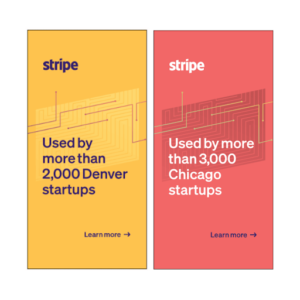
An example of location targeting used in banner ads
Colour and branding is important
Whilst it’s important to use colours that match your brand guidelines, it’s just as important to use colours that complement or contrast well (if you are going for a colourful approach). However, try to avoid using too much colour as it can look like a rainbow has vomited on your canvas, which is unattractive and abrasive to the viewer’s eye.
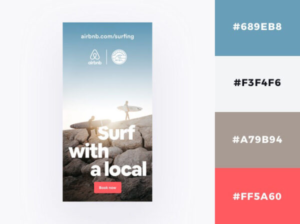
This banner ad by Airbnb utilises its logo’s hot coral colour (#FF5A60) and fuses this with 3 other complementary colours to not only complement each other but make the CTA stand out whilst staying within its brand guidelines. This is a great banner ad!
Create size variants
As you may have noticed from browsing the web yourself, banner ads can come in a few different sizes, which is why it’s important that you are creating different sized ads to fit these different dimensions.
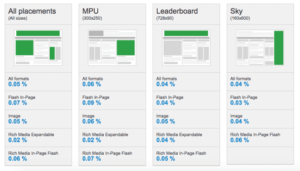
Specifications made by Google for ads are the following:
File types
Formats: GIF, JPG, PNG
Max. size: 150 KB
Ad sizes
Square and rectangle
200 × 200 small square
240 × 400 vertical rectangle
250 × 250 square
250 × 360 triple widescreen
300 × 250 inline rectangle
336 × 280 large rectangle
580 × 400 netboard
Skyscraper
120 × 600 skyscraper
160 × 600 wide skyscraper
300 × 600 half-page ad
300 × 1050 portrait
Leaderboard
468 × 60 banner
728 × 90 leaderboard
930 × 180 top banner
970 × 90 large leaderboard
970 × 250 billboard
980 × 120 panorama
Mobile
300 × 50 mobile banner
320 × 50 mobile banner
320 × 100 large mobile banner
Try to be unique & test, test, test!
Being unique is the relatively easy part of this statement, as you need to match your brand and try to stand out from your competition and web pages in general. The harder part is testing these ads and trying to figure out what works and doesn’t work so that you can capitalise on these tests to truly optimise your banner ad campaign.
Don’t overlay logos and buttons
Returning to the theme of “no clutter allowed” is the rule of no overlays. Your ad should be composed correctly so that buttons and logos have their own individual spaces with the banner ad. If logos and buttons are overlying each other, then things can look very cluttered, very quickly.
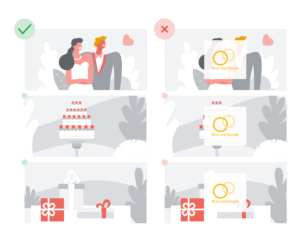
Be accessible
1 in 12 men and 1 in 200 women are colour blind. For simplicity’s sake, let’s say your ad is viewed by 100,000 people at a 50/50 split of men and women. This would mean that over 4,100 of the men and 250 of the women who view your ads are colourblind in one way or another.
You can resolve the issue of these users not reading your ad by following simple accessibility guidelines such as: ensuring text colour and backgrounds have a suitable level of contrast and you aren’t grouping items of the banner ad too close together.
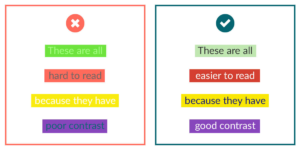
Last but most importantly, have a good landing page
If you want your banner ads to be truly effective and gain you new leads and conversions, then it’s important that the banner ad takes the user to a landing page that is:
- Relevant to the ad
- Geared to optimise conversions on-page
- Organised correctly and easy to read
- Mobile friendly
- Tailored to the ad’s targeting
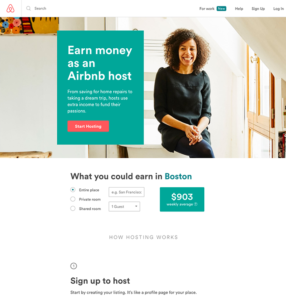
Once again we’re referring to Airbnb here, as this is a landing page for one of their banner ads which they use to get room owners to sign up and use their service. The top of their page is clear and concise, the page references the location they are targeting (Boston), and there’s even a great little tool to showcase potential earnings to the room owners, which I’m sure must work as a conversion powerhouse!
How to Set Up a Display Campaign in Google Ads
- The first thing you need to do is open Google Ads (duh…) and click the “campaigns” tab on the left side of the screen.

- When you’re on the campaigns screen, click the blue circle that contains a giant “+” symbol. This will take you to the new campaign setup page.
- When here, select your campaign goal and underneath this, the “campaign type” box will appear. Here is where you’ll select “display” as your campaign type.

- Once you have done this, we suggest selecting a standard campaign if you have someone to manage it, as a smart display campaign can eat your budget up very quickly.
- Add your relevant landing page URL and give the campaign a relevant name.
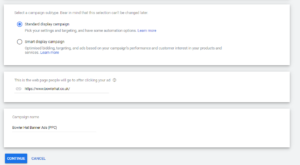
- Click continue and you will then be greeted by the campaign settings page. Here you will input locations and languages to target. Select your relevant locations and languages you want to target in this campaign and advance onto “budget and bidding”.
- Budget and bidding allow you to set an average daily budget for this display campaign. It is worth noting that this is not a daily budget limit, so sometimes your campaign may go over budget slightly.
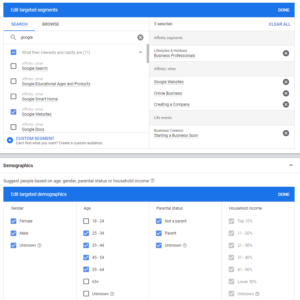
- Once you’ve confirmed your budget and bidding options, you get to choose your target audience and demographics, here is an example of how we may use it to target potential PPC leads.
- The last step, once you have set up your targeting, is to upload your banner ad, which is quite straightforward. You do this by clicking the box that says “Responsive display ad” and changing the setting to upload display ads.
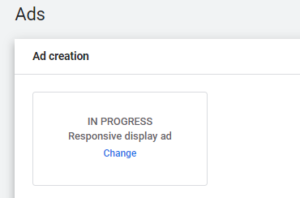
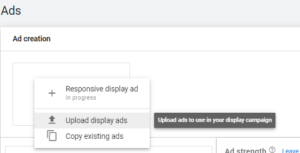
- After you have uploaded your ads, all you have to do is review your campaign set-up and confirm! There you have your own display banner ad campaign set up and ready to go.
- It’s important to note that once the ads are live that you have a competent PPC manager to truly optimise your campaign and ensure the maximum return on investment. If you need help with your PPC management then check out our PPC services.
Display Banner Ads: Conclusion
I hope you’ve found this fundamental guide to display and banner ads useful in determining your strategy for any banner ad campaigns you were unsure about. Whilst we have covered the disadvantages of banner ads, I believe the advantages vastly outweigh and counter many of the disadvantages of display banner ads. They are a fairly cost-effective type of advertising that is great at bringing in web traffic and leads (when optimised correctly) whilst guaranteeing you an increase in brand awareness.
If you would like to get in touch with Bowler Hat regarding PPC services, or even if you just need help with anything PPC or digital marketing related, contact us here or give us a ring at: 0121 315 2001




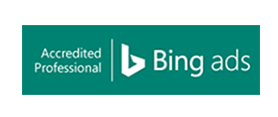




5 Responses
Google Display Ads is good place for marketing. The Article is good to learn for beginners. Great Work.
I read the blog and I found it helpful. It helped me understand google banner ads as a beginner, thank you for sharing.
Thank you for the post, it is very informative. Every thing is explained in detail , Google display ads is a good source to generate traffic for your website
First of all appreciation for choosing this topic where both these terms are often confused among the marketers. Good work in explaining the concept so well. Thank you for the knowledge sharing.
No problem! Glad I could help 🙂